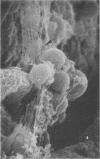Abstract
Antibiotic-treated and untreated Syrian hamsters were inoculated intragastrically with Candida albicans to determine whether C. albicans could opportunistically colonize the gastrointestinal tract and disseminate to visceral organs. Antibiotic treatment decreased the total population levels of the indigenous bacterial flora and predisposed hamsters to gastrointestinal overgrowth and subsequent systemic dissemination by C. albicans in 86% of the animals. Both control hamsters not given antibiotics and antibiotic-treated animals reconventionalized with an indigenous microflora showed significantly lower gut populations of C. albicans, and C. albicans organisms were cultured from the visceral organs of 0 and 10% of the animals, respectively. Conversely, non-antibiotic-treated hamsters inoculated repeatedly with C. albicans had high numbers of C. albicans in the gut, and viable C. albicans was recovered from the visceral organs of 53% of the animals. Examination of the mucosal surfaces from test and control animals indicated further that animals which contained a complex indigenous microflora had significantly lower numbers of C. albicans associated with their gut walls than did antibiotic-treated animals. The ability of C. albicans to associate with intestinal mucosal surfaces also was tested by an in vitro adhesion assay. The results indicate that the indigenous microflora reduced the mucosal association of C. albicans by forming a dense layer of bacteria in the mucus gel, out-competing yeast cells for adhesion sites, and producing inhibitor substances (possibly volatile fatty acids, secondary bile acids, or both) that reduced C. albicans adhesion. It is suggested, therefore, that the indigenous intestinal microflora suppresses C. albicans colonization and dissemination from the gut by inhibiting Candida-mucosal association and reducing C. albicans population levels in the gut.
Full text
PDF

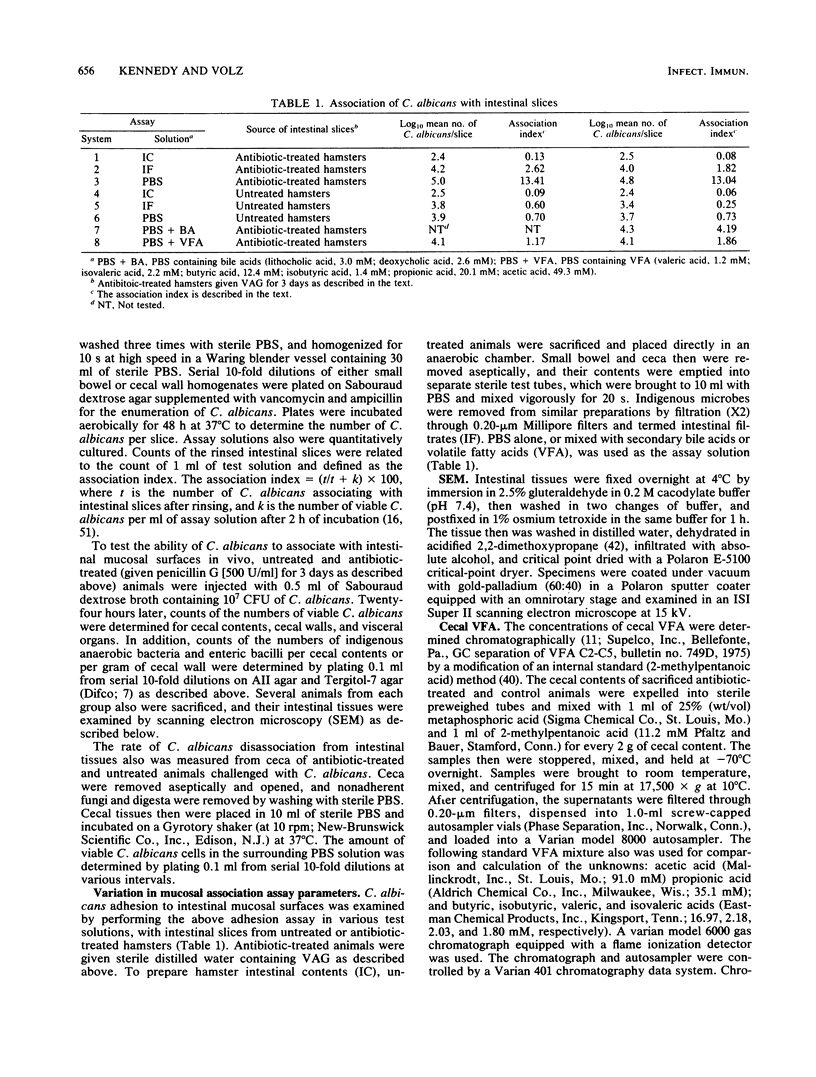
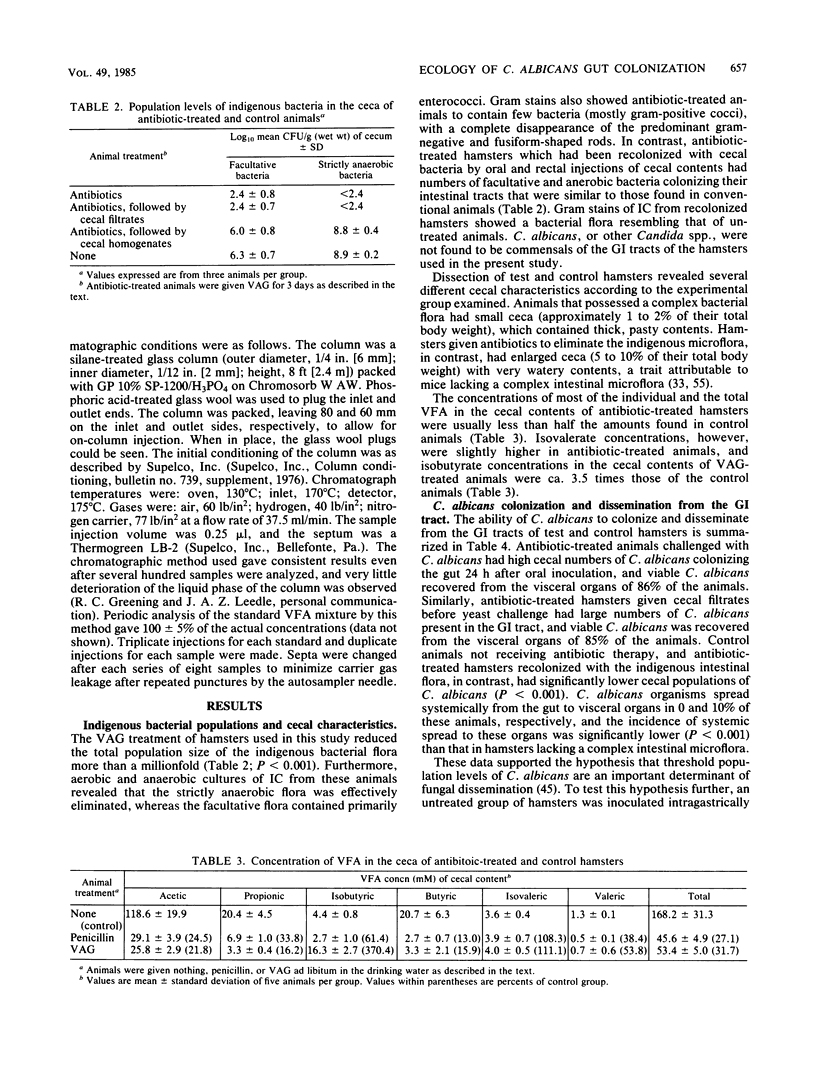
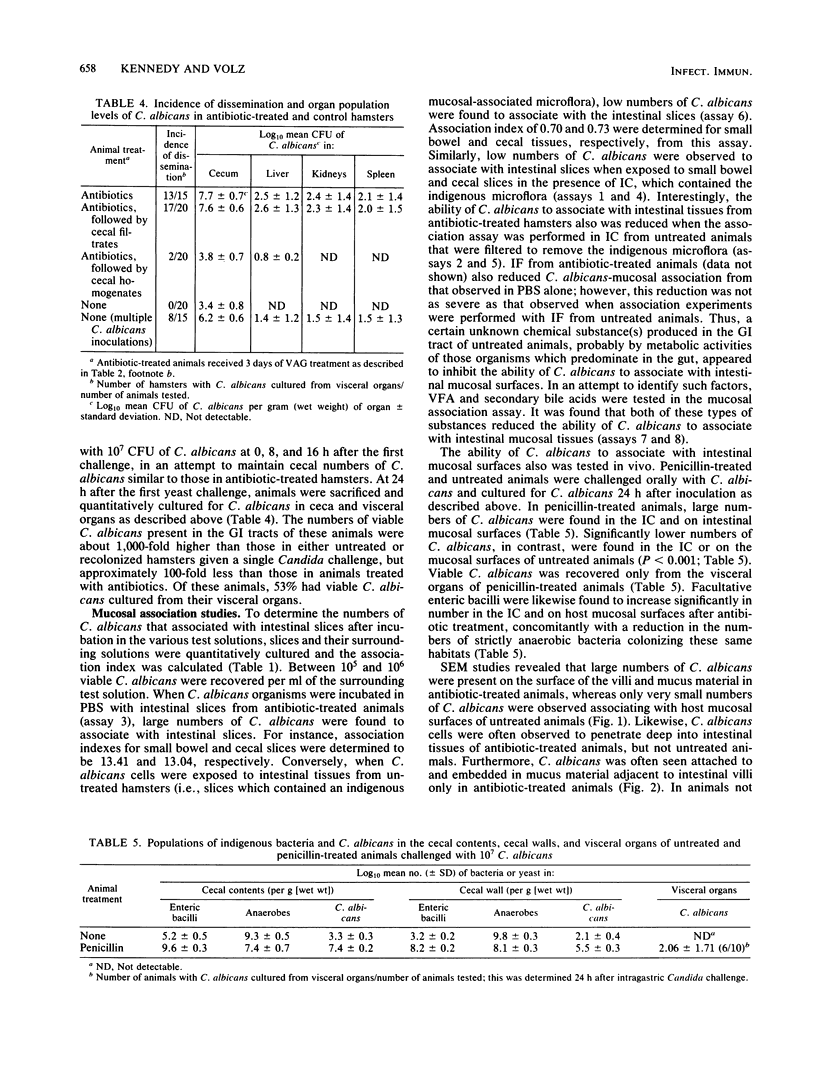
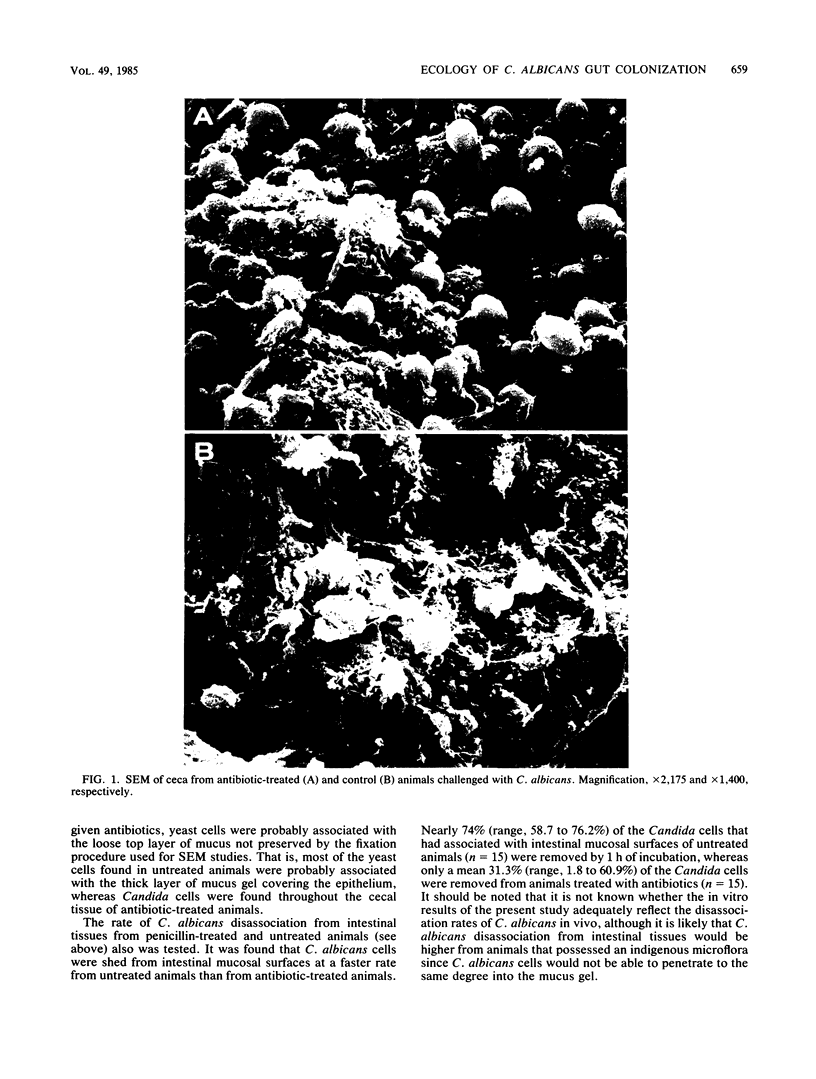
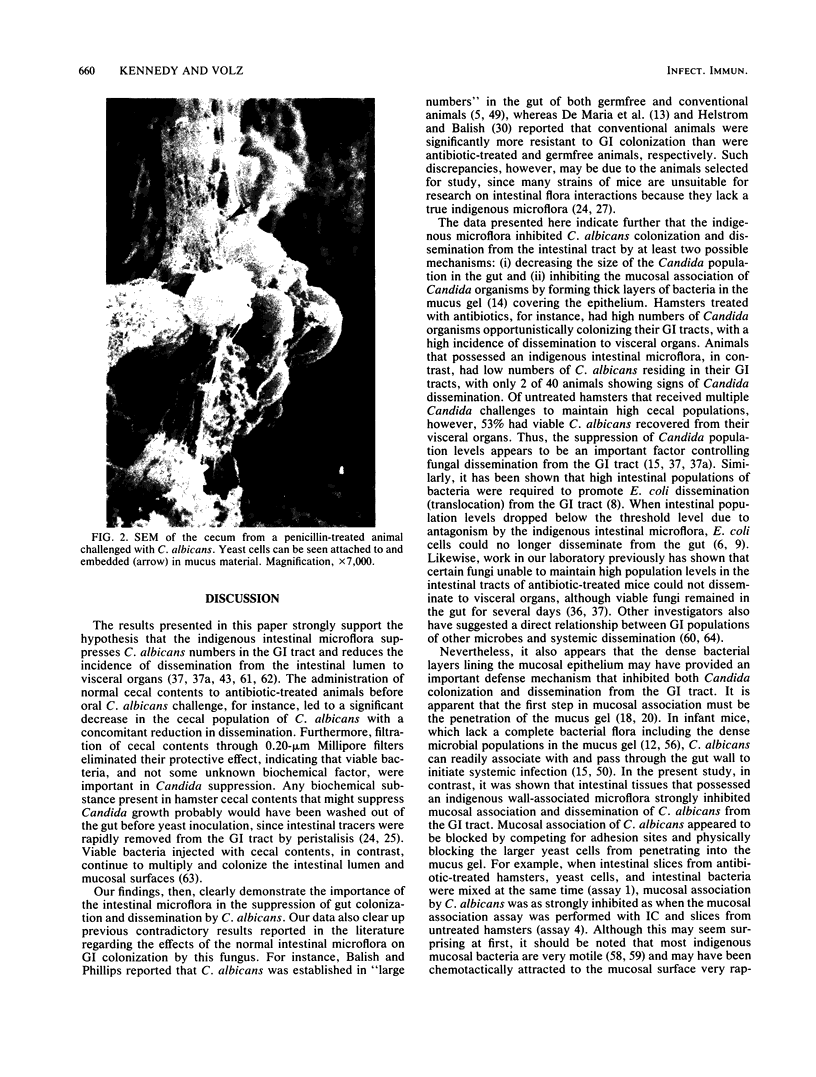

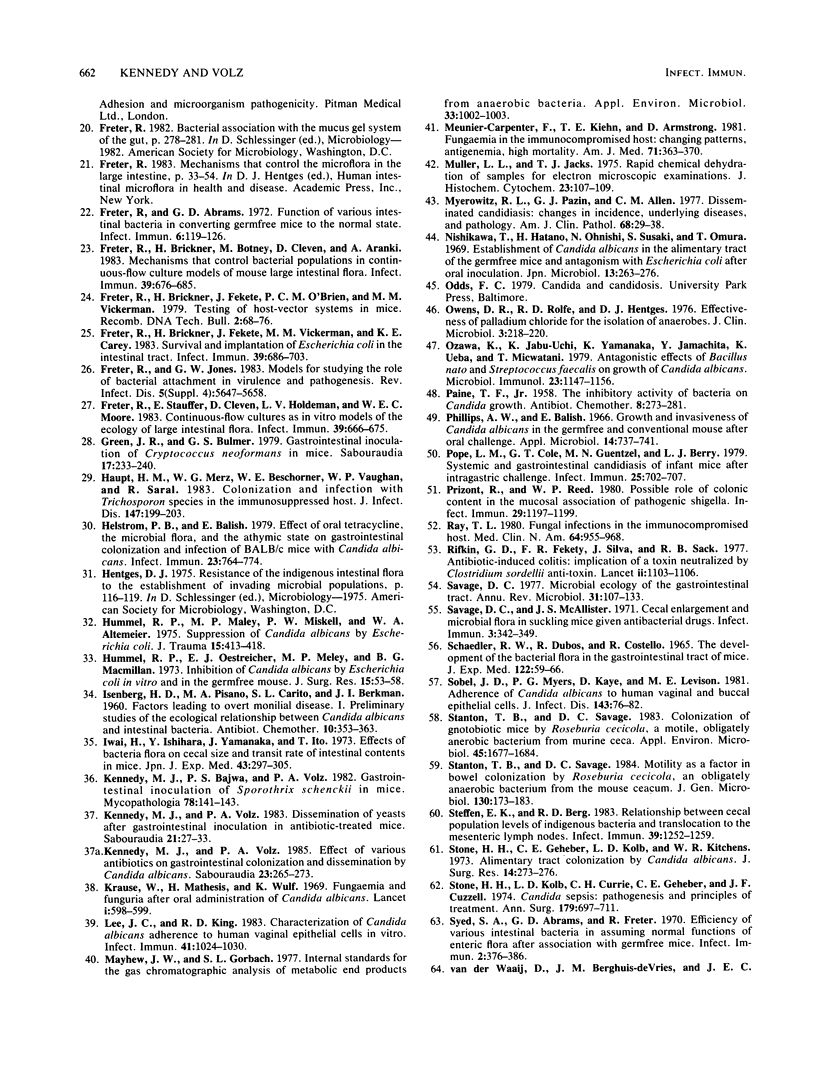
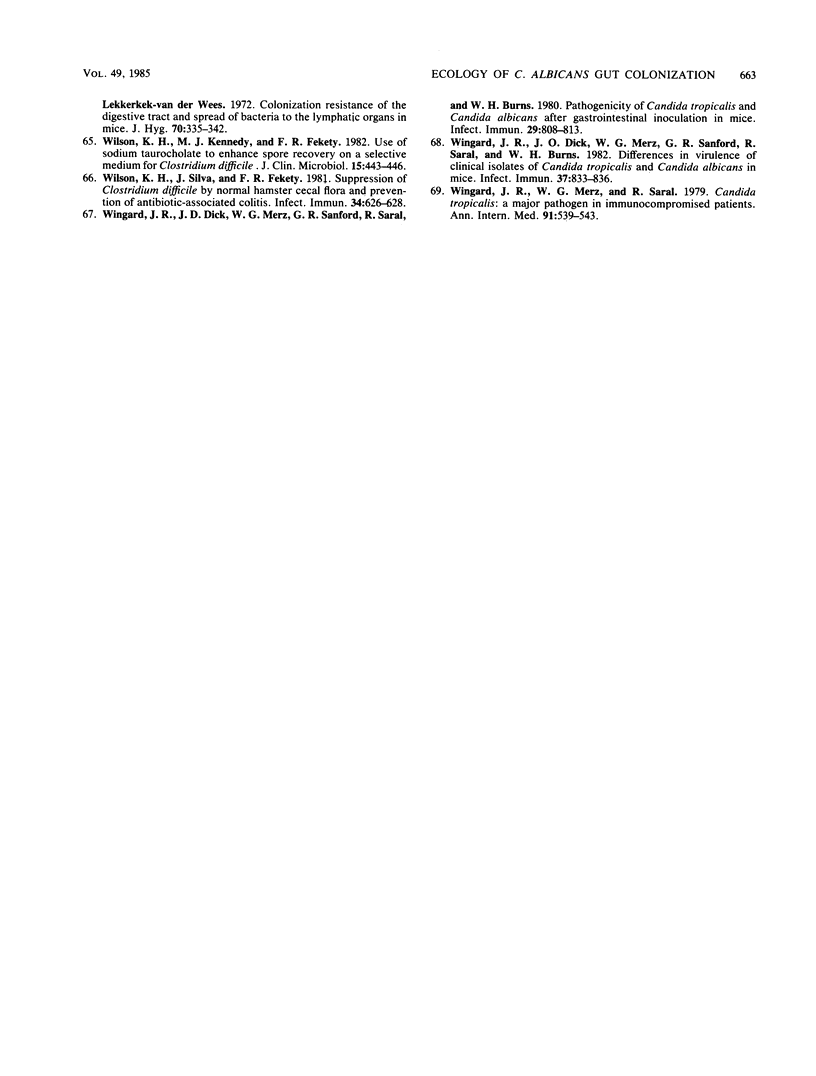
Images in this article
Selected References
These references are in PubMed. This may not be the complete list of references from this article.
- Allweiss B., Dostal J., Carey K. E., Edwards T. F., Freter R. The role of chemotaxis in the ecology of bacterial pathogens of mucosal surfaces. Nature. 1977 Mar 31;266(5601):448–450. doi: 10.1038/266448a0. [DOI] [PubMed] [Google Scholar]
- Andremont A., Raibaud P., Tancrède C. Effect of erythromycin on microbial antagonisms: a study in gnotobiotic mice associated with a human fecal flora. J Infect Dis. 1983 Sep;148(3):579–587. doi: 10.1093/infdis/148.3.579. [DOI] [PubMed] [Google Scholar]
- Aranki A., Freter R. Use of anaerobic glove boxes for the cultivation of strictly anaerobic bacteria. Am J Clin Nutr. 1972 Dec;25(12):1329–1334. doi: 10.1093/ajcn/25.12.1329. [DOI] [PubMed] [Google Scholar]
- Balish E., Phillips A. W. Growth and virulence of Candida albicans after oral inoculation in the chick with a monoflora of either Escherichia coli or Streptococcus faecalis. J Bacteriol. 1966 May;91(5):1744–1749. doi: 10.1128/jb.91.5.1744-1749.1966. [DOI] [PMC free article] [PubMed] [Google Scholar]
- Balish E., Phillips A. W. Growth, morphogenesis, and virulence of Candida albicans after oral inoculation in the germ-free and conventional chick. J Bacteriol. 1966 May;91(5):1736–1743. doi: 10.1128/jb.91.5.1736-1743.1966. [DOI] [PMC free article] [PubMed] [Google Scholar]
- Berg R. D., Garlington A. W. Translocation of certain indigenous bacteria from the gastrointestinal tract to the mesenteric lymph nodes and other organs in a gnotobiotic mouse model. Infect Immun. 1979 Feb;23(2):403–411. doi: 10.1128/iai.23.2.403-411.1979. [DOI] [PMC free article] [PubMed] [Google Scholar]
- Berg R. D. Inhibition of Escherichia coli translocation from the gastrointestinal tract by normal cecal flora in gnotobiotic or antibiotic-decontaminated mice. Infect Immun. 1980 Sep;29(3):1073–1081. doi: 10.1128/iai.29.3.1073-1081.1980. [DOI] [PMC free article] [PubMed] [Google Scholar]
- Berg R. D., Owens W. E. Inhibition of translocation of viable Escherichia coli from the gastrointestinal tract of mice by bacterial antagonism. Infect Immun. 1979 Sep;25(3):820–827. doi: 10.1128/iai.25.3.820-827.1979. [DOI] [PMC free article] [PubMed] [Google Scholar]
- Berg R. D. Promotion of the translocation of enteric bacteria from the gastrointestinal tracts of mice by oral treatment with penicillin, clindamycin, or metronidazole. Infect Immun. 1981 Sep;33(3):854–861. doi: 10.1128/iai.33.3.854-861.1981. [DOI] [PMC free article] [PubMed] [Google Scholar]
- Clark J. D. Influence of antibiotics or certain intestinal bacteria on orally administered Candida albicans in germ-free and conventional mice. Infect Immun. 1971 Dec;4(6):731–737. doi: 10.1128/iai.4.6.731-737.1971. [DOI] [PMC free article] [PubMed] [Google Scholar]
- DUBOS R., SCHAEDLER R. W., COSTELLO R., HOET P. INDIGENOUS, NORMAL, AND AUTOCHTHONOUS FLORA OF THE GASTROINTESTINAL TRACT. J Exp Med. 1965 Jul 1;122:67–76. doi: 10.1084/jem.122.1.67. [DOI] [PMC free article] [PubMed] [Google Scholar]
- Davis C. P., McAllister J. S., Savage D. C. Microbial colonization of the intestinal epithelium in suckling mice. Infect Immun. 1973 Apr;7(4):666–672. doi: 10.1128/iai.7.4.666-672.1973. [DOI] [PMC free article] [PubMed] [Google Scholar]
- DeMaria A., Buckley H., von Lichtenberg F. Gastrointestinal candidiasis in rats treated with antibiotics, cortisone, and azathioprine. Infect Immun. 1976 Jun;13(6):1761–1770. doi: 10.1128/iai.13.6.1761-1770.1976. [DOI] [PMC free article] [PubMed] [Google Scholar]
- Field L. H., Pope L. M., Cole G. T., Guentzel M. N., Berry L. J. Persistence and spread of Candida albicans after intragastric inoculation of infant mice. Infect Immun. 1981 Feb;31(2):783–791. doi: 10.1128/iai.31.2.783-791.1981. [DOI] [PMC free article] [PubMed] [Google Scholar]
- Freter R., Abrams G. D. Function of various intestinal bacteria in converting germfree mice to the normal state. Infect Immun. 1972 Aug;6(2):119–126. doi: 10.1128/iai.6.2.119-126.1972. [DOI] [PMC free article] [PubMed] [Google Scholar]
- Freter R., Brickner H., Botney M., Cleven D., Aranki A. Mechanisms that control bacterial populations in continuous-flow culture models of mouse large intestinal flora. Infect Immun. 1983 Feb;39(2):676–685. doi: 10.1128/iai.39.2.676-685.1983. [DOI] [PMC free article] [PubMed] [Google Scholar]
- Freter R., Brickner H., Fekete J., Vickerman M. M., Carey K. E. Survival and implantation of Escherichia coli in the intestinal tract. Infect Immun. 1983 Feb;39(2):686–703. doi: 10.1128/iai.39.2.686-703.1983. [DOI] [PMC free article] [PubMed] [Google Scholar]
- Freter R. Mechanisms of association of bacteria with mucosal surfaces. Ciba Found Symp. 1981;80:36–55. doi: 10.1002/9780470720639.ch4. [DOI] [PubMed] [Google Scholar]
- Freter R., Stauffer E., Cleven D., Holdeman L. V., Moore W. E. Continuous-flow cultures as in vitro models of the ecology of large intestinal flora. Infect Immun. 1983 Feb;39(2):666–675. doi: 10.1128/iai.39.2.666-675.1983. [DOI] [PMC free article] [PubMed] [Google Scholar]
- Green J. R., Bulmer G. S. Gastrointestinal inoculation of Cryptococcus neoformans in mice. Sabouraudia. 1979 Sep;17(3):233–240. [PubMed] [Google Scholar]
- Haupt H. M., Merz W. G., Beschorner W. E., Vaughan W. P., Saral R. Colonization and infection with Trichosporon species in the immunosuppressed host. J Infect Dis. 1983 Feb;147(2):199–203. doi: 10.1093/infdis/147.2.199. [DOI] [PubMed] [Google Scholar]
- Helstrom P. B., Balish E. Effect of oral tetracycline, the microbial flora, and the athymic state on gastrointestinal colonization and infection of BALB/c mice with Candida albicans. Infect Immun. 1979 Mar;23(3):764–774. doi: 10.1128/iai.23.3.764-774.1979. [DOI] [PMC free article] [PubMed] [Google Scholar]
- Hummel R. P., Maley M. P., Miskell P. W., Altemeier W. A. Suppression of Candida albicans by Escherichia coli. J Trauma. 1975 May;15(5):413–418. doi: 10.1097/00005373-197505000-00007. [DOI] [PubMed] [Google Scholar]
- Hummel R. P., Oestreicher E. J., Maley M. P., Macmillan B. G. Inhibition of Candida albicans by Escherichia coli in vitro and in the germfree mouse. J Surg Res. 1973 Jul;15(1):53–58. doi: 10.1016/0022-4804(73)90163-7. [DOI] [PubMed] [Google Scholar]
- ISENBERG H. D., PISANO M. A., CARITO S. L., BERKMAN J. I. Factors leading to overt monilial disease. I. Preliminary studies of the ecological relationship between Candida albicans and intestinal bacteria. Antibiot Chemother. 1960 Jun;10:353–363. [PubMed] [Google Scholar]
- Iwai H., Ishihara Y., Yamanaka J., Ito T. Effects of bacterial flora on cecal size and transit rate of intestinal contents in mice. Jpn J Exp Med. 1973 Aug;43(4):297–305. [PubMed] [Google Scholar]
- Kennedy M. J., Bajwa P. S., Volz P. A. Gastrointestinal inoculation of Sporothrix schenckii in mice. Mycopathologia. 1982 Jun 18;78(3):141–143. doi: 10.1007/BF00466067. [DOI] [PubMed] [Google Scholar]
- Kennedy M. J., Volz P. A. Dissemination of yeasts after gastrointestinal inoculation in antibiotic-treated mice. Sabouraudia. 1983 Mar;21(1):27–33. doi: 10.1080/00362178385380051. [DOI] [PubMed] [Google Scholar]
- Kennedy M. J., Volz P. A. Effect of various antibiotics on gastrointestinal colonization and dissemination by Candida albicans. Sabouraudia. 1985 Aug;23(4):265–273. doi: 10.1080/00362178585380391. [DOI] [PubMed] [Google Scholar]
- Krause W., Matheis H., Wulf K. Fungaemia and funguria after oral administration of Candida albicans. Lancet. 1969 Mar 22;1(7595):598–599. doi: 10.1016/s0140-6736(69)91534-7. [DOI] [PubMed] [Google Scholar]
- Lee J. C., King R. D. Characterization of Candida albicans adherence to human vaginal epithelial cells in vitro. Infect Immun. 1983 Sep;41(3):1024–1030. doi: 10.1128/iai.41.3.1024-1030.1983. [DOI] [PMC free article] [PubMed] [Google Scholar]
- Mayhew J. W., Gorbach S. L. Internal standards for gas chromatographic analysis of metabolic end products from anaerobic bacteria. Appl Environ Microbiol. 1977 Apr;33(4):1002–1003. doi: 10.1128/aem.33.4.1002-1003.1977. [DOI] [PMC free article] [PubMed] [Google Scholar]
- Meunier-Carpentier F., Kiehn T. E., Armstrong D. Fungemia in the immunocompromised host. Changing patterns, antigenemia, high mortality. Am J Med. 1981 Sep;71(3):363–370. doi: 10.1016/0002-9343(81)90162-5. [DOI] [PubMed] [Google Scholar]
- Muller L. L., Jacks T. J. Rapid chemical dehydration of samples for electron microscopic examinations. J Histochem Cytochem. 1975 Feb;23(2):107–110. doi: 10.1177/23.2.1117127. [DOI] [PubMed] [Google Scholar]
- Myerowitz R. L., Pazin G. J., Allen C. M. Disseminated candidiasis. Changes in incidence, underlying diseases, and pathology. Am J Clin Pathol. 1977 Jul;68(1):29–38. doi: 10.1093/ajcp/68.1.29. [DOI] [PubMed] [Google Scholar]
- Nishikawa T., Hatano H., Ohnishi N., Sasaki S., Nomura T. Establishment of Candida albicans in the alimentary tract of the germ-free mice and antagonism with Escherichia coli after oral inoculation. Jpn J Microbiol. 1969 Sep;13(3):263–276. doi: 10.1111/j.1348-0421.1969.tb00466.x. [DOI] [PubMed] [Google Scholar]
- Owens D. R., Rolfe R. D., Hentges D. J. Effectiveness of palladium chloride for the isolation of anaerobes. J Clin Microbiol. 1976 Feb;3(2):218–220. doi: 10.1128/jcm.3.2.218-220.1976. [DOI] [PMC free article] [PubMed] [Google Scholar]
- Ozawa K., Yagu-Uchi K., Yamanaka K., Yamashita Y., Ueba K., Miwatani T. Antagonistic effects of Bacillus natto and Streptococcus faecalis on growth of Candida albicans. Microbiol Immunol. 1979;23(12):1147–1156. doi: 10.1111/j.1348-0421.1979.tb00547.x. [DOI] [PubMed] [Google Scholar]
- Phillips A. W., Balish E. Growth and invasiveness of Candida albicans in the germ-free and conventional mouse after oral challenge. Appl Microbiol. 1966 Sep;14(5):737–741. doi: 10.1128/am.14.5.737-741.1966. [DOI] [PMC free article] [PubMed] [Google Scholar]
- Pope L. M., Cole G. T., Guentzel M. N., Berry L. J. Systemic and gastrointestinal candidiasis of infant mice after intragastric challenge. Infect Immun. 1979 Aug;25(2):702–707. doi: 10.1128/iai.25.2.702-707.1979. [DOI] [PMC free article] [PubMed] [Google Scholar]
- Prizont R., Reed W. P. Possible role of colonic content in the mucosal association of pathogenic shigella. Infect Immun. 1980 Sep;29(3):1197–1199. doi: 10.1128/iai.29.3.1197-1199.1980. [DOI] [PMC free article] [PubMed] [Google Scholar]
- Ray T. L. Fungal infections in the immunocompromised host. Med Clin North Am. 1980 Sep;64(5):955–968. doi: 10.1016/s0025-7125(16)31576-0. [DOI] [PubMed] [Google Scholar]
- Rifkin G. D., Fekety F. R., Silva J., Jr Antibiotic-induced colitis implication of a toxin neutralised by Clostridium sordellii antitoxin. Lancet. 1977 Nov 26;2(8048):1103–1106. doi: 10.1016/s0140-6736(77)90547-5. [DOI] [PubMed] [Google Scholar]
- SCHAEDLER R. W., DUBOS R., COSTELLO R. THE DEVELOPMENT OF THE BACTERIAL FLORA IN THE GASTROINTESTINAL TRACT OF MICE. J Exp Med. 1965 Jul 1;122:59–66. doi: 10.1084/jem.122.1.59. [DOI] [PMC free article] [PubMed] [Google Scholar]
- Savage D. C., McAllister J. S. Cecal enlargement and microbial flora in suckling mice given antibacterial drugs. Infect Immun. 1971 Feb;3(2):342–349. doi: 10.1128/iai.3.2.342-349.1971. [DOI] [PMC free article] [PubMed] [Google Scholar]
- Savage D. C. Microbial ecology of the gastrointestinal tract. Annu Rev Microbiol. 1977;31:107–133. doi: 10.1146/annurev.mi.31.100177.000543. [DOI] [PubMed] [Google Scholar]
- Sobel J. D., Myers P. G., Kaye D., Levison M. E. Adherence of Candida albicans to human vaginal and buccal epithelial cells. J Infect Dis. 1981 Jan;143(1):76–82. doi: 10.1093/infdis/143.1.76. [DOI] [PubMed] [Google Scholar]
- Stanton T. B., Savage D. C. Colonization of gnotobiotic mice by Roseburia cecicola, a motile, obligately anaerobic bacterium from murine ceca. Appl Environ Microbiol. 1983 May;45(5):1677–1684. doi: 10.1128/aem.45.5.1677-1684.1983. [DOI] [PMC free article] [PubMed] [Google Scholar]
- Stanton T. B., Savage D. C. Motility as a factor in bowel colonization by Roseburia cecicola, an obligately anaerobic bacterium from the mouse caecum. J Gen Microbiol. 1984 Jan;130(1):173–183. doi: 10.1099/00221287-130-1-173. [DOI] [PubMed] [Google Scholar]
- Steffen E. K., Berg R. D. Relationship between cecal population levels of indigenous bacteria and translocation to the mesenteric lymph nodes. Infect Immun. 1983 Mar;39(3):1252–1259. doi: 10.1128/iai.39.3.1252-1259.1983. [DOI] [PMC free article] [PubMed] [Google Scholar]
- Stone H. H., Geheber C. E., Kolb L. D., Kitchens W. R. Alimentary tract colonization by Candida albicans. J Surg Res. 1973 Apr;14(4):273–276. doi: 10.1016/0022-4804(73)90028-0. [DOI] [PubMed] [Google Scholar]
- Stone H. H., Kolb L. D., Currie C. A., Geheber C. E., Cuzzell J. Z. Candida sepsis: pathogenesis and principles of treatments. Ann Surg. 1974 May;179(5):697–711. doi: 10.1097/00000658-197405000-00024. [DOI] [PMC free article] [PubMed] [Google Scholar]
- Syed S. A., Abrams G. D., Freter R. Efficiency of various intestinal bacteria in assuming normal functions of enteric flora after association with germ-free mice. Infect Immun. 1970 Oct;2(4):376–386. doi: 10.1128/iai.2.4.376-386.1970. [DOI] [PMC free article] [PubMed] [Google Scholar]
- Wilson K. H., Kennedy M. J., Fekety F. R. Use of sodium taurocholate to enhance spore recovery on a medium selective for Clostridium difficile. J Clin Microbiol. 1982 Mar;15(3):443–446. doi: 10.1128/jcm.15.3.443-446.1982. [DOI] [PMC free article] [PubMed] [Google Scholar]
- Wilson K. H., Silva J., Fekety F. R. Suppression of Clostridium difficile by normal hamster cecal flora and prevention of antibiotic-associated cecitis. Infect Immun. 1981 Nov;34(2):626–628. doi: 10.1128/iai.34.2.626-628.1981. [DOI] [PMC free article] [PubMed] [Google Scholar]
- Wingard J. R., Dick J. D., Merz W. G., Sandford G. R., Saral R., Burns W. H. Differences in virulence of clinical isolates of Candida tropicalis and Candida albicans in mice. Infect Immun. 1982 Aug;37(2):833–836. doi: 10.1128/iai.37.2.833-836.1982. [DOI] [PMC free article] [PubMed] [Google Scholar]
- Wingard J. R., Dick J. D., Merz W. G., Sandford G. R., Saral R., Burns W. H. Pathogenicity of Candida tropicalis and Candida albicans after gastrointestinal inoculation in mice. Infect Immun. 1980 Aug;29(2):808–813. doi: 10.1128/iai.29.2.808-813.1980. [DOI] [PMC free article] [PubMed] [Google Scholar]
- Wingard J. R., Merz W. G., Saral R. Candida tropicalis: a major pathogen in immunocompromised patients. Ann Intern Med. 1979 Oct;91(4):539–543. doi: 10.7326/0003-4819-91-4-539. [DOI] [PubMed] [Google Scholar]
- van der Waaij D., Berghuis-de Vries J. M., Lekkerkerk-van der Wees Colonization resistance of the digestive tract and the spread of bacteria to the lymphatic organs in mice. J Hyg (Lond) 1972 Jun;70(2):335–342. doi: 10.1017/s0022172400022385. [DOI] [PMC free article] [PubMed] [Google Scholar]




